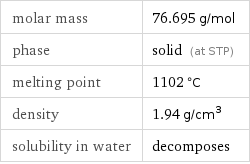Input interpretation

magnesium silicide
Chemical names and formulas

formula | Mg_2Si name | magnesium silicide alternate names | dimagnesium monosilicide | dimagnesium silicide | magnesium, compound with silicon (2:1) mass fractions | Mg (magnesium) 63.4% | Si (silicon) 36.6%
Lewis structure

Draw the Lewis structure of magnesium silicide. Start by drawing the overall structure of the molecule, ignoring potential double and triple bonds: Count the total valence electrons of the magnesium (n_Mg, val = 2) and silicon (n_Si, val = 4) atoms: 2 n_Mg, val + n_Si, val = 8 Calculate the number of electrons needed to completely fill the valence shells for magnesium (n_Mg, full = 4) and silicon (n_Si, full = 8): 2 n_Mg, full + n_Si, full = 16 Subtracting these two numbers shows that 16 - 8 = 8 bonding electrons are needed. Each bond has two electrons, so in addition to the 2 bonds already present in the diagram add 2 bonds. To minimize formal charge silicon wants 4 bonds and magnesium wants 2 bonds. Identify the atoms that want additional bonds and the number of electrons remaining on each atom: Fill in the 2 bonds by pairing electrons between adjacent highlighted atoms: Answer: | |
Basic properties

molar mass | 76.695 g/mol phase | solid (at STP) melting point | 1102 °C density | 1.94 g/cm^3 solubility in water | decomposes
Units

Solid properties (at STP)

density | 1.94 g/cm^3
Units

Chemical identifiers
![CAS number | 22831-39-6 PubChem CID number | 89858 PubChem SID number | 24861130 SMILES identifier | [Mg]=[Si]=[Mg] InChI identifier | InChI=1/2Mg.Si/rMg2Si/c1-3-2 MDL number | MFCD00016202](../image_source/a4bf5e109153ffd3a901a932876d51c1.png)
CAS number | 22831-39-6 PubChem CID number | 89858 PubChem SID number | 24861130 SMILES identifier | [Mg]=[Si]=[Mg] InChI identifier | InChI=1/2Mg.Si/rMg2Si/c1-3-2 MDL number | MFCD00016202
NFPA label

NFPA label

NFPA hazards | water reactive